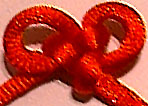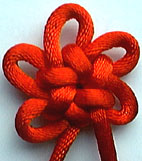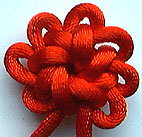 Generalities
Generalities Generalities
GeneralitiesI previously chose to give it the name of flower knot because I've always thought of its basic shape and ordinal variations as flowers. I have since decided that this is incorrect and will be using cloverleaf going forward.
Part of the problem that I was trying to avoid was the cloverleaf/round brocade issue. In Chinese, this knot is called cloverleaf if the number of ears is 5 or less and round brocade if 6 or more. The arbitrary change in name based on the number of ears is mildly confusing, but I have faith in your ability to keep up, even when I'm being inconsistent.
Chen 1: Cloverleaf Knot (酢漿草, 酢浆 草) [zuòjiāngcǎo] (3, 4), Round Brocade Knot (團錦, 团锦) [tuán jǐn] (6)Strict translation of the Chinese (酢漿草, zuòjiāngcǎo, 酢浆草) for the triangular cloverleaf (3 petal cloverleaf) or square cloverleaf (4 petal cloverleaf) gives oxalis corniculata or woodsorrel, a clover-like plant.
The Japanese (几帳結び: 几帳(キチョウ)(きちょう)(kichoo) 結び (ムスビ)(むす び)(musubi)) machine translates as "screen".
The Korean (생쪽매듭, saengjjok) translates as "ginger knot", which in French is "gingembre".
The hexagonal cloverleaf knot is more commonly known as the round brocade knot (團錦, tuán jǐn, 团锦) which machine retranslates (iTranslate) as "mission jin". Individually, the characters 團 translate as "ball" and 錦 "brocade" (noun) or "glorious" (adj). A final note to the Chinese translation fun, is that the simplified version (versus the traditional above) of these same characters are very different (团锦) unlike the simplifed for the square cloverleaf.
The Japanese (錦結び: 錦(ニシキ)(にしき)(nishiki) 結び(ムスビ)(むすび) (musubi)) machine translates to English as "brocade".
The Korean (매듭매듭, maehwa maedeup) is known as the "plum blossom knot" but literally "knot knot". "Plum blossom" is "매화" (maehwa). I've seen this more than once, though, perhaps it's a typo that's been repeated via cut and paste? To round out the list of languages for which I have official or semi-official translations or canonical names, the French name for this knot (as translated from Korean) is "prunier".
 4.
4.  5.
5.  5o2.
5o2.  6.
6.  7.
7.  8.
8.  9.
9. 
 The 4 cloverleaf is probably the most common of the cloverleaf knots,
especially since it is easy to combine many of them into a single
design. For this reason, detailed
instructions are given for this particular cloverleaf.
The 4 cloverleaf is probably the most common of the cloverleaf knots,
especially since it is easy to combine many of them into a single
design. For this reason, detailed
instructions are given for this particular cloverleaf.
 The procedure to make 3 cloverleaf is exactly the same as the 4 cloverleaf except that you do step 1, skip step 2 and go directly
to step 3.
The procedure to make 3 cloverleaf is exactly the same as the 4 cloverleaf except that you do step 1, skip step 2 and go directly
to step 3.
 The procedure to make 5 cloverleaf can be exactly the same as the 4 cloverleaf except that you add an extra loop
between step 2 and step 3. As you can see from this illustration, however, the centre is
already getting quite large and loose, and if the centre doesn't
hold the whole knot will fall apart. A modification that will be
introduced for 6 cloverleaf can also be used for 5 cloverleaf. As always,
the option is yours.
The procedure to make 5 cloverleaf can be exactly the same as the 4 cloverleaf except that you add an extra loop
between step 2 and step 3. As you can see from this illustration, however, the centre is
already getting quite large and loose, and if the centre doesn't
hold the whole knot will fall apart. A modification that will be
introduced for 6 cloverleaf can also be used for 5 cloverleaf. As always,
the option is yours.
 This variant of the 5 cloverleaf is made with the same centre doubling
strategy as is used in making the 6
cloverleaf except, of course, leaving out step 3 so that you only have 5
petals.
This variant of the 5 cloverleaf is made with the same centre doubling
strategy as is used in making the 6
cloverleaf except, of course, leaving out step 3 so that you only have 5
petals.
 As the cloverleaf knots get larger, the centers become larger and
looser, holding together more poorly. With the 6 cloverleaf knot, we
introduce the construction variations
that can be used to remedy this problem.
As the cloverleaf knots get larger, the centers become larger and
looser, holding together more poorly. With the 6 cloverleaf knot, we
introduce the construction variations
that can be used to remedy this problem.
 This 7 cloverleaf is made with the same centre doubling strategy as is
used in the making of the 6 cloverleaf.
This 7 cloverleaf is made with the same centre doubling strategy as is
used in the making of the 6 cloverleaf.
 As the 6 cloverleaf is constructed with a
"doubled" centre, so the 8 cloverleaf is constructed with a "tripled" centre.
As the 6 cloverleaf is constructed with a
"doubled" centre, so the 8 cloverleaf is constructed with a "tripled" centre.
 This 9 cloverleaf is made with the same centre tripling strategy as is
used in the making of the 8 cloverleaf.
This 9 cloverleaf is made with the same centre tripling strategy as is
used in the making of the 8 cloverleaf.
Creation Date: Mon Aug 3 22:40:51 PDT 1998
Last Modified: Friday, 15-Apr-2016 03:51:02 UTC
Page accessed at local time: Friday, 26-Apr-2024 11:42:55 UTC